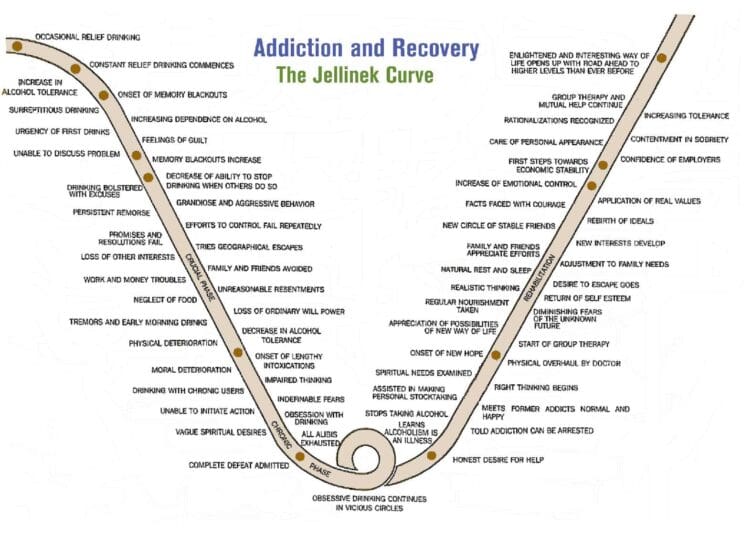Scientists have been trying to develop an addiction vaccine since the 1970s. The complex nature of addiction presents them with challenges that they are still trying to overcome. Let’s have a closer look at the status quo of this research process.
“Absolute Awe” – “Making Life Sparkle” – “Have A Manly Day”
What do those ads for alcoholic beverages want us to believe? Right, that alcohol is fun and sexy! The implication is that with just one magical drink, our lives will transform from mundane and ordinary to thrilling and sophisticated. However, on the flip side, we are presented with another stereotype: that of people struggling with alcohol use disorder (AUD) as red-faced, unkempt individuals with slurred speech and balance problems. Disconcertingly, these two false extremes distort our perception of what constitutes a serious physical and mental disorder.
Same same – but different
The reality of alcoholism is highly complex and unfolds slowly over time. What begins as a casual way to unwind at the end of a long day may eventually lead to addiction. The downward trajectory toward a vicious circle is unique for each individual and is shaped by their biology, upbringing, and environment, resulting in a variety of triggers, timeframes, and causes.
Despite this diversity, however, AUD does follow a certain pattern. To help clarify how this disorder typically progresses, medical professionals have identified four stages, each characterised by signs and symptoms ranging from mild to severe. Identifying the stage of alcoholism can assist in recognising if and what kind of treatment is necessary.
A quick “What is What” of alcohol use
The terms used to describe problem drinking have evolved over the years, so let’s take a closer look at the terminology you likely encounter when browsing articles on this topic:
- Alcohol use disorder is as of 2013, the official term and clinical diagnosis to describe problem drinking. According to the US National Institute on Alcohol Abuse and Alcoholism, AUD is defined as “a medical condition characterized by an impaired ability to stop or control alcohol use despite adverse social, occupational, or health consequences.”[i] Before 2013, AUD was divided into two distinct disorders: “alcohol abuse” and “alcohol dependence.”
- Alcohol abuse described a pattern of drinking too much and too often that can cause you to be unable to fulfil responsibilities at work, home or school, and that can lead to health and social problems.[ii]
- Alcohol dependence refers to increasing tolerance, i. e. you need to drink greater amounts to get the same intended effect. Cardinal features are cravings, compulsion, loss of control over alcohol use, and continued drinking no matter the negative consequences including withdrawal symptoms.[iii]
- Alcoholism has, like “alcohol addiction”, long been retired from official manuals and is nowadays used merely colloquially (and interchangeably) for any of the above-mentioned terms.
The Jellinek Curve
Alcohol has been an integral part of culture since the birth of civilisation, when clean water was not always readily available, and people turned to fermented beverages like beer and wine as a source of hydration. Therefore, it comes as no surprise that the history of drinking problems is as old as the history of alcohol. However, as drinking issues were widely considered the result of moral failing or lack of willpower, research toward understanding the causes and effects of AUD barely existed before the mid-20th century.
Morton Jellinek, a key scientist in the 1940s and 50s, proposed the idea that problem drinking follows a common pattern through various stages.[iv] He created the Jellinek Curve to outline the typical behaviours and symptoms through four stages, as well as the journey out of alcoholism and into the upward trajectory of recovery.[v] While some of his findings have been disproven, his work is still regarded as the groundwork for today’s understanding of AUD.

Stage 1: Pre-alcoholic stage
This earliest stage is the most difficult to spot as it occurs before drinking constitutes a perceptible problem. You may enjoy alcohol consumption more frequently than others, but it could pass as regular social drinking. Even close friends and family members may barely notice symptoms of behaviour changes that would point in the direction of “too much” and “too often.” As society tends to turn a blind eye to—even underage—alcohol use and to excuse or encourage drinking in certain situations (“the kids are just having fun”, “take a beer and relax”), it is even more likely that we shrug off small warning signs such as:
- binge drinking episodes
- relying on alcohol to unwind or to engage in social situations
- needing a drink to cope with the difficulties of daily life or with uncomfortable emotions
Stage 2: Early-stage alcoholism
At this stage, alcohol use starts to be cause for serious concern. It evolves from a mere social activity or casual means to unwind and shifts to the centre of your thoughts and needs (“When can I drink next?”, “Will there be alcohol at the event?”). Drinking still may not be a daily habit, but you indulge in it more frequently as you start craving the mood-altering and mood-regulating sensation of inebriation. All the while, your experience with alcohol continues to be positive, and you don’t see any harm done. Often, others won’t be able to detect overt signs of intoxication, such as stuttering or coordination problems, because your tolerance to alcohol has begun to rise.
Stage 3: Middle alcoholism phase
Although around 20 % of those suffering from AUD are classified as “high-functioning” drinkers, meaning they can go about their lives as usual despite their heavy drinking, their precarious condition will most probably become evident at this stage. At this stage, you will frequently feel the need to downplay the amount you drink and find excuses for your drinking habits. As alcohol has now taken the top spot on your life’s priority list, other aspects such as family, social life, career, and/or education will suffer, accompanied by hazardous behaviour such as driving while intoxicated, drinking while looking after children, or while at work. By now, your body and mind are noticeably affected by facial redness, stomach bloating, shaking, sweating, and memory lapses.
Stage 4: End-stage alcoholism
Once you reach this most dire stage, the consequences of long-term drinking have become impossible to hide. It is evident that you no longer have control over your alcohol consumption, which dictates your every action and decision. Your drinking has severely impacted, if not ruined, your health, relationships, finances, and work/school situation. The shame, depression, or paranoia associated with these events layer over worsening and even life-threatening physical problems, including damage to vital organs such as the brain, heart, liver, and kidneys. At this point, you may feel like you are beyond help, but as frightening as it may be to have reached the end stage of a progression, treatment and recovery are still available and possible.
Getting Help
Once alcoholism takes hold, breaking free can be challenging. There are no quick fixes to a complex and complicated disorder such as addiction, and AUD is certainly no exception. If you or a loved one recognises the signs or symptoms outlined in the four categories above, we urge you not to dismiss or hide them. Seeking help at a rehab facility is not a sign of weakness; instead, it opens a pathway to long-term recovery. Please do not hesitate reach out at any stage to learn more about NEOVIVA’s approach to alcohol treatment.
Sources
[i] https://www.niaaa.nih.gov/publications/brochures-and-fact-sheets/understanding-alcohol-use-disorder. Accessed 13 Dec 2023.
[ii] https://www.niaaa.nih.gov/publications/brochures-and-fact-sheets/alcohol-use-disorder-comparison-between-dsm. Accessed 13 Dec 2023.
[iii] ibid.
[iv] Ward, J. H., Bejarano, W., Babor, T. F., & Allred, N. (2016). Re-introducing Bunky at 125: E. M. Jellinek’s life and contributions to alcohol studies. Journal of Studies on Alcohol and Drugs, 77, 375–383. doi:10.15288/jsad.2016.77.375.
[v] https://www.psychologs.com/the-jellinek-curve-five-phases-of-alcohol-addiction. Accessed 13 Dec 2023.




0 Comments